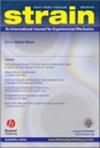Plane–strain condition in plane–strain grooved tensile (PSGT) specimens during traction and creep loading at room and high temperature
IF 2.4
3区 材料科学
Q2 Engineering
引用次数: 0
Abstract
Abstract ISO 23228:2011 proposed a testing method in which the plastic material, experimental resins or compounds for pipes and fittings, can be exposed to stress conditions that mimic internally pressurised end‐capped pipes. The stress conditions are mimicked by the use of a plaque specimen having a grooved reduced section called plane–strain grooved tensile (PSGT) specimens producing a biaxial state of stress under uniaxial loading. In this study, PSGT specimens were cut out from high‐density polyethylene (HDPE) pipes. Two shape ratios, ratio between the width and the groove thickness, were used. Both the axial and transverse displacements and strain fields were followed by a digital image correlation (DIC) camera during tensile and creep loading, both at room and high temperature; furthermore, DIC images were used to estimate the notch opening displacement. The increasing effect of the temperature in both the axial and transverse displacement and strain was highlighted. No significant effect of the width was noticed. The results have evidenced that, as the plane–strain condition in the width is assured during the tests, PSGT specimens can be used to mimic internally pressurised pipes under monotonic increasing or constant‐in‐time loading at both room and high temperature, but it must be better to use specimens with a higher shape ratio, that is, higher width. The results contribute to the 9th Sustainable Development Goal: Industry, Innovation and Infrastructure by promoting a sustainable industrialisation and fostering innovation.平面应变槽拉伸(PSGT)试件在室温和高温牵引和蠕变加载下的平面应变状态
ISO 23228:2011提出了一种测试方法,其中用于管道和配件的塑料材料,实验树脂或化合物可以暴露在模拟内部加压端盖管道的应力条件下。应力条件是通过使用具有凹槽减少部分的斑块试样来模拟的,称为平面应变凹槽拉伸(PSGT)试样,在单轴载荷下产生双轴应力状态。在这项研究中,PSGT样品是从高密度聚乙烯(HDPE)管中切割出来的。采用了两种形状比,即沟槽宽度与沟槽厚度之比。在室温和高温拉伸和蠕变加载过程中,用数字图像相关(DIC)相机记录了轴向和横向位移和应变场;此外,DIC图像用于估计缺口开口位移。温度对轴向和横向位移应变均有显著的增加作用。没有注意到宽度的显著影响。结果表明,在保证宽度平面应变条件的情况下,PSGT试样可以模拟室内和高温下单调递增或恒时加载下的内压管道,但必须采用更高的形比,即更高的宽度。其成果通过促进可持续工业化和促进创新,为第九项可持续发展目标:工业、创新和基础设施做出贡献。
本文章由计算机程序翻译,如有差异,请以英文原文为准。
求助全文
约1分钟内获得全文
求助全文
来源期刊

Strain
MATERIALS SCIENCE, CHARACTERIZATION & TESTING-
CiteScore
4.50
自引率
4.80%
发文量
27
审稿时长
2.3 months
期刊介绍:
Strain is an international journal that contains contributions from leading-edge research on the measurement of the mechanical behaviour of structures and systems. Strain only accepts contributions with sufficient novelty in the design, implementation, and/or validation of experimental methodologies to characterize materials, structures, and systems; i.e. contributions that are limited to the application of established methodologies are outside of the scope of the journal. The journal includes papers from all engineering disciplines that deal with material behaviour and degradation under load, structural design and measurement techniques. Although the thrust of the journal is experimental, numerical simulations and validation are included in the coverage.
Strain welcomes papers that deal with novel work in the following areas:
experimental techniques
non-destructive evaluation techniques
numerical analysis, simulation and validation
residual stress measurement techniques
design of composite structures and components
impact behaviour of materials and structures
signal and image processing
transducer and sensor design
structural health monitoring
biomechanics
extreme environment
micro- and nano-scale testing method.
 求助内容:
求助内容: 应助结果提醒方式:
应助结果提醒方式:


